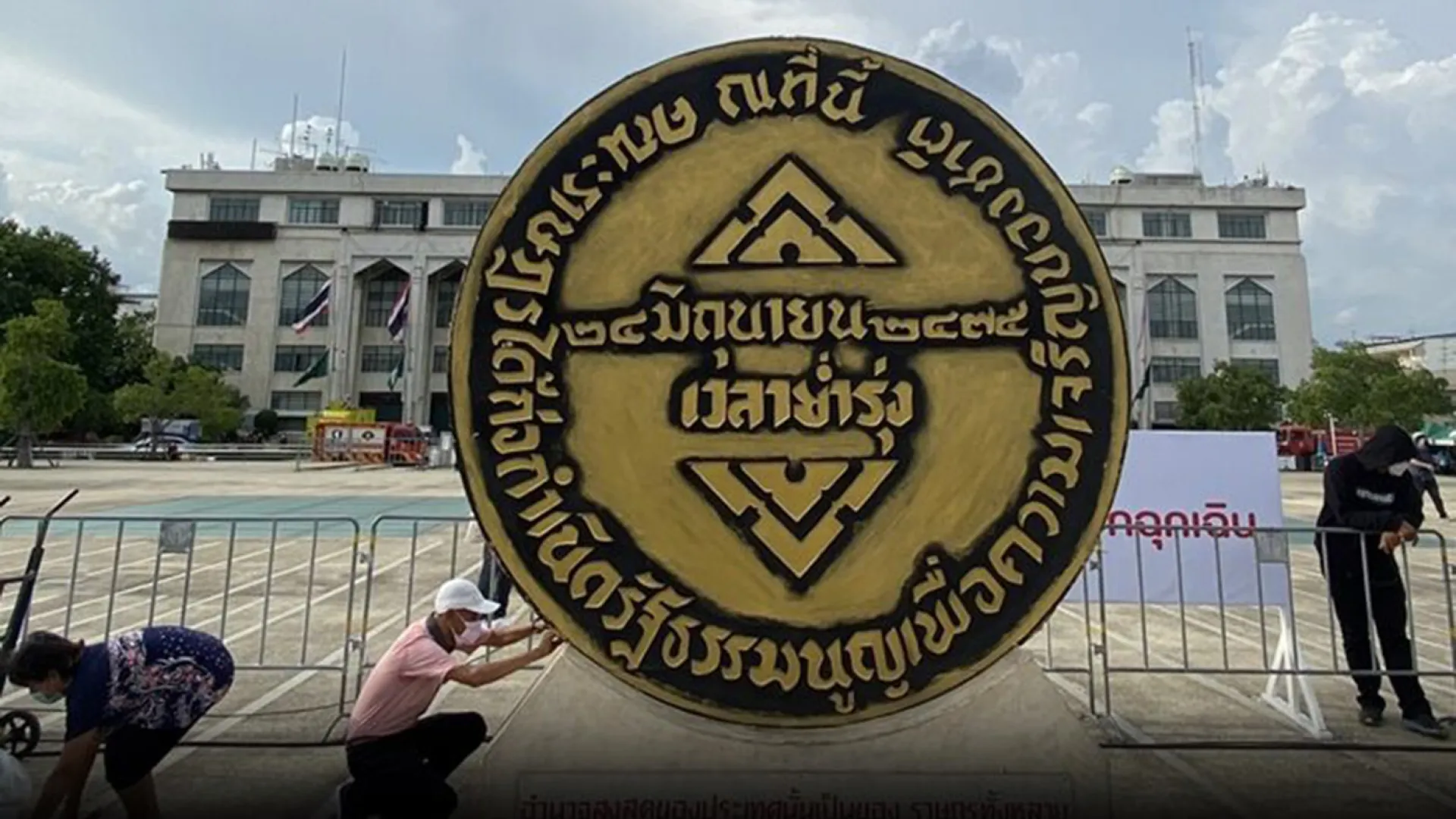After the fall of the People's Party following the coup in 1947, the People's Party Plaque, a symbol of the Siamese Revolution, gradually faded from the collective memory of Thai society, just as the stories about the People's Party did. Images of the People's Party Plaque were rarely seen in public media during the dictatorship era. It wasn’t until after the events of October 14, 1973 that images of the monument began to reappear in publications, such as in the book “Forty-Two Years of the Thai Parliament” by Prasert Patamasukhon. However, even then, the image of the People's Party Plaque was still less common compared to the Democracy Monument, which was seen as the symbol of democracy during that period. It wasn’t until the 1980s that images of the People's Party Plaque began to be reproduced more widely in books. Significantly, on June 24, 1982, Pridi Banomyong gave a lecture on the importance of the People's Party Plaque at the Thai Students Association in France and opened an exhibition titled “50 Years of Thai Democracy,” which prominently featured a large image of the People's Party Plaque. From then on, the monument gradually returned as a symbol of the Siamese Revolution through various forms of reproduction. Examples include printing images of the monument in various publications, organizing annual memorial ceremonies at the monument site at Dusit Palace Plaza every June 24, presenting the monument in artistic works, and creating model replicas of the monument for exhibitions or events related to the Siamese Revolution.
The first model of the People's Party Plaque was created as part of a project to build a sculpture park dedicated to 11 political events in front of the new auditorium at Thammasat University. One of the features was the “Sala Aphiwat” (Revolution Gazebo) which included a stone base with a replica of the People's Party Plaque, symbolizing the historical beginnings of Thai democracy. This was created by the 20th Anniversary of the October 6th Incident Coordination Committee in collaboration with Thammasat University and was inaugurated on June 27, 1998. During the 75th anniversary of the Siamese Revolution in 2007, the Pridi Banomyong Institute organized an outdoor art exhibition in this sculpture park from June 23 to July 1, 2007. An important piece was the “Wheel of History,” created by Sinsawat Yodbangtoey, the Art Division of the Pridi Banomyong Institute, Crescent Moon Theatre, B-Floor Theatre, and theater group Naked Masks. This large replica of the People's Party Plaque was made from painted plywood, with a diameter of about 3 meters. The base of the monument had the inscription “The Sovereignty of the Country Belongs to the People” and featured figures of people pushing and carrying the monument, also made of white-painted plywood. This artwork was positioned near the Sala Aphiwat and was used as a backdrop for art performances and poetry readings. After the exhibition, the large replica was moved to the Pridi Banomyong Institute as a piece of art connected to Pridi Banomyong’s concept of the Siamese Revolution.
Although the replica of the People's Party Plaque is not as significant or valuable as the original as a piece of historical evidence, it serves as a dynamic political symbol that can engage people without needing to be tied to the original site. The creation of replicas is associated with artistic and cultural movements aimed at advancing social and political issues by art practitioners, academics, writers, musicians, and theatrical creators. Since the 1990s, artistic and cultural groups have been influenced by the revival of the People's Party, leading to academic work valuing the art of the People's Party era and creating artworks related to that period. For example, in 1987, Crescent Moon Theatre created the stage play “The Revolutionary,” which tells the story of Pridi Banomyong. Additionally, after the establishment of the Pridi Banomyong Institute in 1995, it has played an important role in supporting cultural activities to continue the ideals of complete democracy, providing a venue for various cultural groups to organize events. The creation of the People's Party Plaque replica is a result of the artistic efforts to revive and continue the ideals of the People's Party, supported by the Pridi Banomyong Institute and Thammasat University. The large replica has played a significant role in making the People's Party Plaque more widely known and in raising public awareness about the importance of the Siamese Revolution on June 24, 1932.
After the original People's Party Plaque at Dusit Palace Plaza disappeared without a trace in April 2017, there was increased interest in the People's Party Plaque, including the creation of new replicas in various forms such as pins, keychains, clocks, t-shirts, and replicas identical to the original. Furthermore, since early 2020, the contemporary political struggle of younger generations has involved using the People's Party Plaque symbol in protests, reflecting the connection between the fight for democracy during the People's Party era and the present day. The large People's Party Plaque replica created in 2007 has been used in various democratic activities, particularly to commemorate the Siamese Revolution from 2021 onwards. For instance, on June 24, 2021, the Thalufah group borrowed the large replica for the event “June 24: Wake Up and Continue the People's Party’s Mission” at the Democracy Monument. Later the same day, the replica was moved to the Parliament for further activities. On June 24, 2022, the large replica was exhibited at the Pridi Banomyong Institute's seminar on the 90th anniversary of the Siamese Revolution at the Siburapha Auditorium, Thammasat University, and in the evening, the Thalufah group moved it to the National Day celebration at the Bangkok City Hall to commemorate the Siamese Revolution and continue the symbol of the struggle for democracy from the People's Party era to later generations. Although the large replica is now deteriorated and no longer usable, it remains a significant artwork that successfully disseminated the memory of the Siamese Revolution and powerfully drove political activities in contemporary Thai society.





